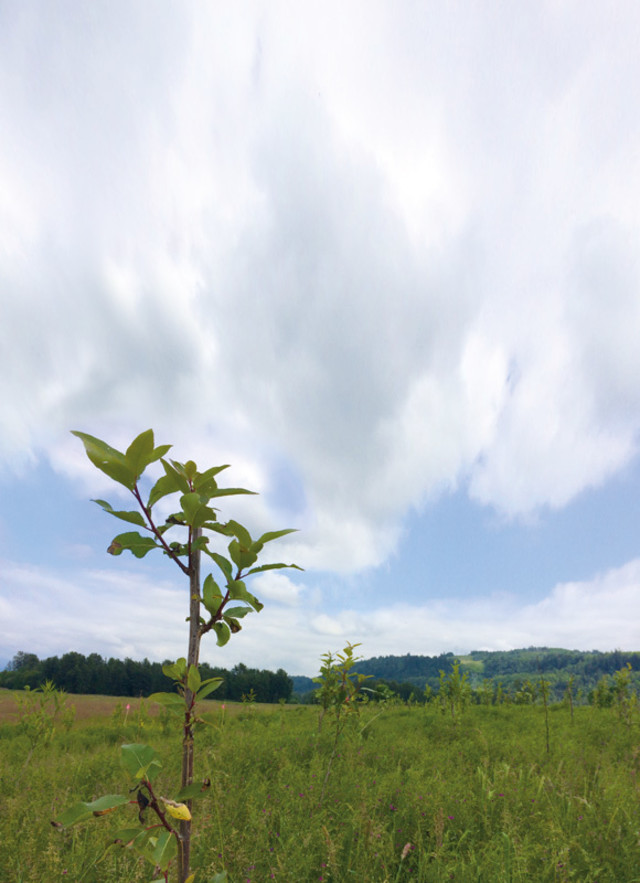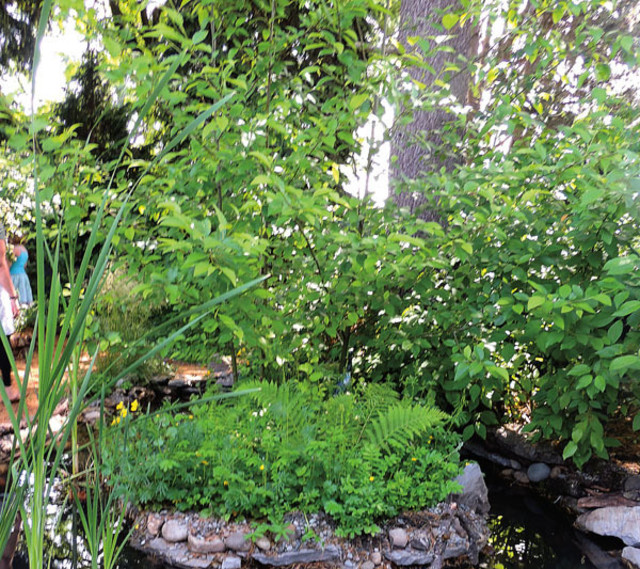Caring for the Planet
2014: Lower Columbia Estuary Partnership
In June 2011, Marshall Johnson, principal restoration ecologist for the Lower Columbia Estuary Partnership, discovered a 1935 aerial photograph of the Sandy River Delta. It showed a thick forest of willows and cottonwoods. He then found another photo from 1948: the forest had been mostly removed to make way for a new highway. The new construction, including a tide gate that blocked salmon from swimming into the wetland in search of food, made the landscape inhospitable for the birds and plants that once called the area home.

The Columbia River, from the Bonneville Dam to the Pacific, is one of 28 “estuaries of national significance” designated by the EPA—it provides integral habitat for salmon and hundreds of other fish and wildlife species. But since 1880, huge swaths of the floodplain habitat have been destroyed. The Estuary Partnership works to revive those ecosystems. In the case of the $1 million, 1,000-acre restoration project at the Sandy River Delta, Johnson is working from the aerial photo to reconstruct what the wetland had looked like before the human disturbance. His organization partnered with the US Forest Service to restore the delta’s original biodiversity, mowing invasive canary grass with a 30-foot combine; planting 1,400 cottonwoods, 1,200 willows, and 600 spirea; and trucking in massive boulders and logs to improve channels for salmon.
There’s still plenty of work to do, but the Sandy project has revealed verdant patches of hope: in one clearing, a thicket of blackberry has given way to native saplings, and on another ridge cottonwood cuttings planted by volunteers blanket two acres. Every day, it’s looking more and more like 1935.
Inspired by our amazing Light a Fire winners? Find out how to give back to
Portland's best nonprofits with our Guide to Giving!
2013: BACKYARD HABITAT CERTIFICATION PROGRAM

UNDER A DARK NORTHWEST canopy, verdant sword ferns and wild oxalis sprout in the underbrush while fearless baby Douglas squirrels scurry down their towering namesake trees. This isn’t a stretch of Forest Park or Oaks Bottom Wildlife Refuge, though. It’s the lawn of West Hills homeowner Lorena O’Neill, and it has earned her the highest honor in the Backyard Habitat Certification Program: platinum.
In a partnership, the Columbia Land Trust and Audubon Society of Portland first piloted the program in 2006 with a handful of homeowners pledging to eradicate the worst invasive plants from their yards (top of the hit list: ivy and blackberry) and to garden solely with Willamette Valley natives. Flash-forward to today: more than 1,750 properties are enrolled across Portland, with at least 50,000 native plants distributed at wholesale prices from local nurseries. Backyards are surveyed by expert technicians, reassessed by an army of trained volunteers, and given a certification level from silver to platinum, with a prominent sign in the front yard championing the achievement.
But habitat certification is about more than one-upping your neighbors or putting a fence around a wild piece of land. “You experience wildlife and preservation at a very personal level in your own backyard,” says O’Neill as she gives a tour, proffering the tart, bright fruits from a thimbleberry shrub.“The program essentially relies on community-based social marketing,” says program manager Gaylen Beatty, “and it’s incredibly effective.” The backyard certification community has grown so rapidly, that the total acreage now amounts to around 330. In comparison, Hoyt Arboretum has 187 acres. Eventually, Beatty hopes, the program will form entirely native corridors throughout the city.

Impact at a Glance
Year Founded
1994
Hours Volunteered In 2011
1,650
Pounds of Garbage Removed In 2011
3,000
When Lewis and Clark first traveled down the Columbia in 1805, the explorers wrote that they were “kept up during the whole of the night by swans and geese.” But by 1955, part of that floodplain, the Columbia Slough, once rich with wildlife, sat clogged with tires, sewage, and garbage. “It was treated like a dump,” says Jane Van Dyke, executive director of the Columbia Slough Watershed Council. For 20 years, Van Dyke’s group—with the help of thousands of volunteers—has removed umpteen tons of garbage (3,000 pounds last year alone), planted native alder and cottonwood trees along denuded banks, and removed invasive weeds, such as reed canary grass, that can choke out native species. Perhaps even more important, the council has helped restore the slough’s reputation as a vital part of the Columbia River ecosystem. (That has been a challenge, considering that the waterway remains largely hidden behind industrial buildings and homes—feeding an out-of-sight, out-of-mind mentality.) Last year, the nonprofit’s Slough School brought 6,157 students to its waters for science-based field trips, and 2,100 people participated in the council’s annual boat trips, walking and paddling tours, and workshops. Those who ply the slough’s highly managed waters by canoe or kayak today may not hear the cacophony of birds that Lewis and Clark did, but they are rewarded by experiencing what many in Portland do not: a hidden oasis that is home to sensitive species like bald eagles, peregrine falcons, and western pond turtles, all harbingers of a waterway that is on the right track.
2011: The Wetlands Conservancy
The next time you sit down to a plate of cedar-plank Pacific salmon for dinner, be sure to raise a glass to the Wetlands Conservancy. Without the group’s effort to educate the public about the importance of wetlands in everything from preventing flooding to their essential role in providing healthy habitats for salmon, your plate might well be empty. Over the course of its 30-year history, the Wetlands Conservancy has helped raise awareness about these sensitive marshy areas with posters, TV spots, and even on-the-ground guerrilla efforts like the neighborhood gathering it organized in June to educate Tigard residents with yards adjacent to the Roger Hart Wetland Preserve about how to plant and care for their land with the wetland in mind (not using pesticides that will run off into the fragile ecosystem, for example). One year, the group ran an Aqua Plate Special at local restaurants and grocery stores to raise awareness, identifying seafood that depends on healthy Oregon estuaries. The effort also netted $9,000 in donations. “We want people to understand how wetlands are more than just really cool spaces,” says the group’s executive director, Esther Lev. “They provide functions that intersect with people’s lives.” The Wetlands Conservancy isn’t just sis-boom-bahing wetland preservation, though; it’s an active player in acquiring land. Since the conservancy was founded three decades ago, it has procured more than 1,600 acres around the state, including a preserve in Yaquina Bay and 56 acres in Tualatin. “The Wetlands Conservancy plays a hugely important role in conservation in Oregon,” says Bob Sallinger, conservation director for the Audubon Society of Portland. “There are a lot of land trusts out there, but the Wetlands Conservancy stands out because they bring science and stewardship to the lands they protect.”
2011: Multnomah Education Service District Outdoor School
Hands up: who’s licked a slug? If you attended the sixth grade in Multnomah County, we’re betting you may have … or that you brought back some other camp stories from Outdoor School, a sleepaway environmental education program that’s become a legendary institution since its inception in 1966. Free to most participants and part of the annual sixth-grade curriculum throughout the county, Outdoor School and its annual team of more than 1,300 high school volunteer counselors ensure every student experiences and learns about the natural world at camps near Corbett and Sandy. Students make leaf rubbings, observe migratory birds, and examine invertebrates under a microscope. (And on a dare, some might even sample “Oregon escargot.”) There are other lessons too: away from home and outside of embedded social patterns, Outdoor School creates a safe space for personal growth. “Even the students who were troublemakers in the classroom opened up and had the time of their lives,” says Katie Kramer, who spent five springs as an Outdoor School counselor and special-needs volunteer. “They got a taste of being part of something bigger than themselves: a community.”
2010: NORTHWEST EARTH INSTITUTE
Twenty years ago, Dick Roy quit his job at a law firm to form the Northwest Earth Institute (NWEI) with his wife, Jeanne. Their goal? To inspire mainstream workplaces to initiate eco-friendly programs in the office. With the help of an NWEI volunteer, groups of about 10 people gather once or twice a week for an hour to discuss ways to take responsibility for both their own well-being and the planet’s. In the first year, 97 workplace groups signed up for the inaugural course, “Exploring Deep Ecology.” “Nature isn’t just a place to go on vacation—it’s the air we breathe, the water we drink, and the food we eat,” says NWEI’s executive director, Mike Mercer. Clearly, the message spoke to the masses: this year, 10,000 people participated in eight of NWEI’s programs, and courses are popping up all over the country in private homes, faith centers, nonprofits, and universities. NWEI also recently celebrated its second successful EcoChallenge, in which teams take active steps toward a healthy future by tackling two-week eco-goals like saving water, finding sustainable food solutions, and generating less waste. “Sustainable choices don’t just benefit polar bears and glaciers,” Mercer says. “What’s good for the planet is also good for your family.” And for your soul.
